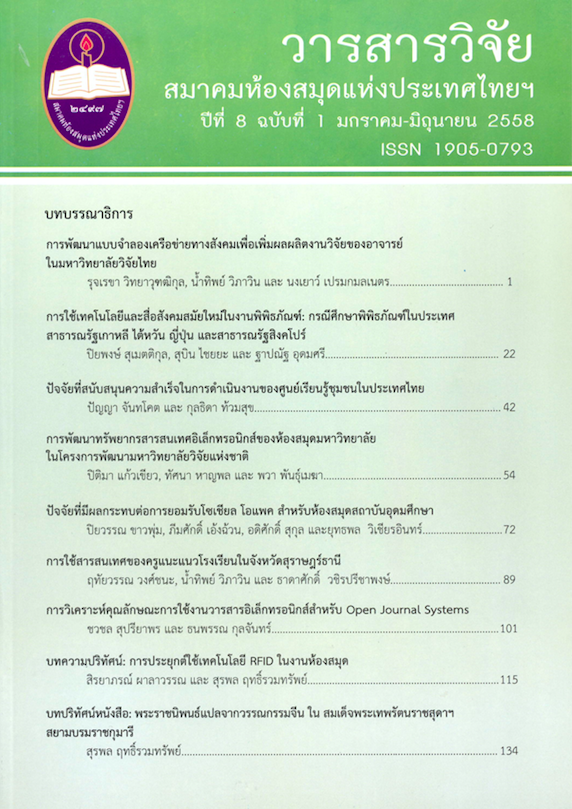ปัจจัยที่มีผลกระทบต่อการยอมรับโซเชียล โอแพค สำหรับห้องสมุดสถาบันอุดมศึกษา
Main Article Content
Abstract
การวิจัยครั้งนี้ มีวัตถุประสงค์เพื่อศึกษา (1) ปัจจัยที่มีผลกระทบต่อการยอมรับโซเชียล โอแพค สำหรับผู้ใช้บริการห้องสมุดสถาบันอุดมศึกษาของรัฐ (2) ตัวแบบการพยากรณ์ (Prediction) และตัวแปรที่มีผลกระทบต่อการยอมรับโซเชียล โอแพค กับความถี่ในการสืบค้นโซเชียล โอแพค
วิธีการวิจัยเป็นการวิจัยเชิงสำรวจ กลุ่มตัวอย่างที่ใช้ในการศึกษาคือ ผู้ใช้บริการในการสืบค้นสารสนเทศออนไลน์ โซเชียล โอแพค จากห้องสมุดสถาบันอุดมศึกษาของรัฐ 5 แห่ง จำนวน 379 คน ได้มาจากการแบ่งชั้นภูมิตามสถานศึกษา โดยใช้แบบสอบถามออนไลน์เป็นเครื่องมือในการเก็บรวบรวมข้อมูล สถิติที่ใช้ในการวิเคราะห์ข้อมูล ได้แก่ ค่าความถี่ ค่าร้อยละ ค่าเฉลี่ย ค่าส่วนเบี่ยงเบนมาตรฐาน และการหาค่าการวิเคราะห์ถดถอยพหุคูณ
ผลสรุปการวิจัยครั้งนี้พบว่า ผู้ใช้ยอมรับโซเชียล โอแพค ด้านการสังเกตได้ของนวัตกรรม และด้านความเข้ากันได้ของนวัตกรรม ซึ่งเป็นตัวแปรที่อธิบายแนวโน้มความถี่ในการสืบค้น Quick Search และการสืบค้น Advanced Search มากที่สุด ตามลำดับ ในขณะที่ผู้ใช้ยอมรับโซเชียล โอแพค ด้านประโยชน์เชิงเปรียบเทียบของนวัตกรรม เป็นตัวแปรที่อธิบายแนวโน้มความถี่ในการสืบค้น Heading Search และการสืบค้น 3 ประเภท มากที่สุด อย่างมีนัยสำคัญทางสถิติที่ระดับ 0.05 ซึ่งสนับสนุนและสอดคล้องกับสมมติฐานการวิจัยที่ตั้งไว้
Factors Affecting the Adoption of Social OPAC for Academic Libraries
Piyawan Khawphum1, Peemasak Angchun2, Adisak Sukul3, Yudthaphon Vichianin4
1Master student, Department of Library and Information Sciences, Faculty of Humanities, Ramkhamhaeng University
2Ph.D. (Library and Information Science), Faculty member of the Department of Library and Information Sciences, Faculty of Humanities, Ramkhamhaeng University
3 Ph.D. (Computer Science), Faculty member of the Department of Computer Science, Faculty of Science, King Mongkut’s Institute of Technologies Ladkrabang
4 Ph.D. (Communication and Information Sciences), Assistant Professor, Department of Radiological Technology, Faculty of Medical Technology, Mahidol University
The objectives of this research were to: 1) study factors affecting the adoption of social OPAC for academic libraries 2) study the prediction and variable of Social OPAC uses and the frequency of Social OPAC uses. The number of samples in this study was 379 users of Social OPAC for Academic Libraries.
This research use online questionnaire tested about factors that affect the Diffusion and Adoption of Social OPAC. Using techniques of descriptive statistics, the researcher analyzed the data collected in terms of percentage, frequency, mean and standard deviation. Multiple regression analysis method was also employed to test research hypotheses. Findings are as followings: The aspect of observe ability and compatibility of innovation affected the adoption of Social OPAC and were the explanatory variables for frequency in retrieving information using Quick Search and Advanced Search. Also, the aspect of relative advantage in innovation affected the adoption of Social OPAC and was an explanatory variable towards frequency in the retrieval of information using Heading Search and all three searching apparatuses mentioned.
Article Details
บทความทุกเรื่องที่ลงตีพิมพ์จะได้รับการตรวจอ่านโดยผู้ทรงคุณวุฒิ ความคิดเห็นและบทความที่ปรากฏในวารสารนี้ เป็นของผู้เขียนซึ่งมิใช่เป็นความคิดเห็นของคณะผู้จัดทำ และมิใช่ความรับผิดชอบของสมาคมห้องสมุดแห่งประเทศไทยฯ การนำบทความในวารสารนี้ไปตีพิมพ์ซ้ำต้องได้รับอนุญาตจากคณะผู้จัดทำ
All articles submitted for publication will be reviewed by the academic reviewers. The editorial board and TLA claim no responsibility for the content or opinions expressed by the authors of individual articles or columns in this journal. Reprinting of any articles in this journal must be permitted by the editorial board.


